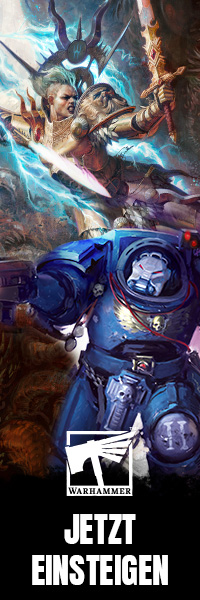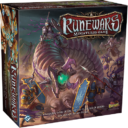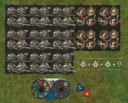Runewars: Kampfpreview
Im neuesten Vorschau-Artikel zeigen Fantasy Flight Games, wie der Kampf bei Runewars funktionieren wird.
Battle Is Joined
Preview Combat in Runewars Miniatures Game
“Place me at the head of a mustered Army of the Realm, my peers, and I will venture forth to eradicate the traitor in the Mistlands and the undead with him.”
–Baron Zachareth of Cartridge, speaking in the Council of ThirteenThe great battles of Terrinoth are beginning, as Waiqar’s undead grow more bold with every passing day. Waiqar the Undying will soon make his next move to cover the world in darkness, and only the legions of the Daqan Lords dare to take up arms and stand against him. In Runewars Miniatures Game, you will choose your side and take your place in the next great war.
We’ve already taken a closer look at several aspects of Runewars Miniatures Game. We interviewed designer Andrew Fischer to explore the thought that went into the game’s design. We took a closer look at the command tools that grant you precise control over your units on the battlefield. And last week, we marched onto the battlefield itself as we previewed the different ways your units can move.
Today, however, we turn our attention to the fundamental struggle between man and undead—the brutal combat of Runewars, and how you can lead your units through the coming battles.
Draw Your Swords
Once your units have maneuvered into position, you’ll be ready to attack your opponent’s units, whether you’re drawing swords and entering the frantic scrum of melee combat or striking from afar with arrows or magic. Every attack can slay enemy figures and every unit you destroy is worth victory points at the end of the game, along with the objectives you complete. (We’ll take a closer look at objectives in our next preview.)
Waging war is no easy business, however, and dozens of figures will die on both sides before your battle is done. You’ll kill enemy figures by making attacks, but your units won’t simply seize any opportunity to attack—instead, you must prepare your attacks by plotting a melee or ranged attack on your command tool.
The outcomes of your attacks are decided by rolling custom dice. Every unit has one or more attack profiles along the bottom edge of its unit card, and these attack profiles determine the dice your unit rolls in combat. For instance, the Daqan Lords’ Spearmen rolls one red die and one blue die during melee combat. Because the Spearmen don’t have a ranged attack profile, they’re incapable of making ranged attacks.
The dice that you roll feature a variety of symbols, and each symbol allows you to gain the upper hand in a different way:
Hit – Hits can be spent by the attacker to deal damage and possibly inflict wounds. This is the fundamental way for you to destroy enemy units.
Surge – Surges are used to trigger special abilities. These special abilities may be found on your unit card or an upgrade card attached to your unit.
Mortal Strike – A mortal strike deals one wound to your target, regardless of that unit’s defense. This powerful symbol is only found on the white dice wielded by the mightiest warriors.
Morale – At the end of the attack, you can spend morale symbols to inflict a morale test on the defender. We’ll explore morale tests in more detail later in this preview.
Accuracy – The accuracy result lets you target a specific figure in the enemy unit, perhaps forcing your opponent to deal wounds to a commander, rather than a simple foot soldier.
The most common way to receive these symbols is from your attack dice, but they may also come from your modifier dial. For instance, when you plot a melee attack on your Spearmen action dial, you can also plot a hit symbol on the modifier dial, which automatically adds a bonus hit to your attack! Other units can supplement their attacks by adding other symbols, including surge, morale, or accuracy results.
Multiply Your Force
The dice that you roll during an attack are always determined by your unit’s attack profile, and you’ll roll the same dice, whether your unit has thirty figures or three. The size of your unit does have a significant impact on your attacks, however, and every rank and column of figures is important.
In this case, three hits, split between your dice and your modifier dial, translates to nine damage!
Wider units can bring more fighters to bear against the enemy, which directly translates to more damage. While you’re making an attack, each hit symbol (whether it comes from your dice or your modifier dial) deals damage equal to the number of figure trays facing your target. So, in the example above, a block of Spearmen is attacking a group of Reanimates. Because the Spearmen have three trays in the rank facing the Reanimates, their three hit results will deal nine damage!
In a massive block of infantry, even warriors behind the front ranks can contribute to the battle by the sheer weight and pressure of their bodies. For every full rank of trays behind your unit’s front rank, you can choose and reroll any number of dice in your attack, giving you better odds of dealing maximum damage. Even a partial rank (a rank with fewer trays than your front rank) allows you to reroll a single die in your attack!
An enemy attack may deal significant damage, but that doesn’t necessarily translate into an equal number of dead figures. In the upper left corner of every unit card, you’ll find that unit’s defense and its wound threshold, as you can see above. The defense value is the amount of damage the unit must suffer in order to take a wound, and the wound threshold is the number of wounds that each figure can take.
Because the Reanimates have a defense of one and a wound threshold of one, nine damage translates to nine killed figures.
As an example, the Reanimates from our earlier example have a defense of one and a wound threshold of one. This means that every damage will inflict one wound, and one wound will kill a figure. If the Spearmen are dealing nine damage to the Reanimates, then they will remove nine figures from the enemy formation, as shown above.
Of course, there are ways to increase your defense. Almost every unit can plot a modifier that raises its defense strength, which can significantly reduce casualties. If the Reanimates above had a defense value of two, nine damage would only kill four figures—the final point of damage would not surpass the Reanimates’ defense, and it would be lost.
Even the most heavily armored unit can still be terrified or have its spirit broken, however. After your attack, you can spend your morale results and any morale tokens on the defending unit to test the unit’s might. The number of morale symbols spent determines the number of cards that you draw from the morale deck. For instance, if you inflict a morale test with two morale symbols, you’ll draw two morale cards from the deck.
Morale cards feature a number of dangerous results, and receiving any one of them at the wrong time could be disastrous. A unit may be cast into Disarray, forcing it to suffer a stun token, while a Loss of Faith removes an entire tray from the unit. Enemy soldiers may even suffer from Uncertainty, letting you perform a reform action with the enemy unit, turning it to face whatever direction you choose!
You’ll also notice that each morale card features a number of icons at the top of the card. The number of these symbols limits which cards you can trigger—for example, if you inflict a morale test with two morale symbols, you can trigger Uncertainty, but not Betrayal. Inflicting terror, doubt, and confusion on the enemy ranks is a crucial part of achieving victory in Runewars Miniatures Game, and the best commanders will consistently use it to their advantage.
Lead Your Army
The enemy ranks are drawn up across the valley—and soon, blood and carnage will overwhelm this pastoral scene. Join us for our next preview, as we explore the setup for each battle and the objectives you pursue, and remember to pre-order Runewars Miniatures Game at your local retailer today!
Der deutschen Vertrieb der Fantasy Flight Produkte liegt bei Heidelberger.
Link: Fantasy Flight Games















Ich habe es durchgelesen, aber eins habe ich nicht entdeckt? Spielt die Ausrichtung der Figuren eine Rolle (Flanke, Rückseite)?
Zudem habe ich noch nicht recht verstanden, wie das Entfernen von Verlusten gehandhabt wird: entferne ich die Figuren und/oder Trays? Und von wo?
Auf dem Bild mit den 9 Verlusten wird eine einzelne Mini von einer der 4er Gruppen entfernt, also werden die wohl nicht darauf festgeklebt.
Die Ausrichtung dürfte eine Rolle spielen, weil explizit gesagt wird, dass die eine Moralaktion einem erlaubt, die gegnerische Einheit umzuformieren, und zwar „turning it to face whatever direction you choose“. Die Karte wäre recht sinnlos, wenn Flanken- und Rückenangriffe keinen Effekt hätten.
Ich durfte auf der Spiel 2016 das ganze mal Probespielen. Verluste wurden dabei immer einzeln von einem Baseplättchen entfernt, bis das entweder leer war oder keine Verluste mehr übrig waren. Sobald ein Tray leer war musste dieses entfernt werden, was aufgrund der Tatsache dass die Trays beim bewegen nicht auseinander fallen sollen leider recht schwer ging. Was leider immer wieder zu Verrutschern führte.
Ja die Ausrichtung der Regimenter wird eine Rolle spielen, hierzu gab es im FFG Forum mal ein Statement:
„We didn’t use the flank rules in the demos just to simplify things down a bit. If you are flanking an enemy in melee, you get an extra die when attacking (blue or red, your choice). When the flanked unit is attacking you, they get no rerolls no matter how many ranks they have, and their threat is determined by the number of trays on the contacting edge.
It’s important to remember that casualties come from the back row of trays first, and the attacker decides which back row tray they come off of, so if you knock out a tray on the contacted edge, you could really hamper their return damage quickly. In the full game, good positioning will be huge.“
zu deiner 2. Frage: Ja man entfernt tatsächlich die Miniaturen, aber immer Tray weise, also alle 4 Figurenverluste muss ein Tray entfernt werden und das wirkt sich dann auf die Anzahl an Verlusten/Rerolls aus welche man im Kampf zur Verfügung hat. Ich schätze mal von hinten @ wo Trays entfernen.
Super, vielen Dank für die Infos.
Was ich ja mag, sind die Würfel mit Symbolen, weil sie das Spielerlebnis erweitern (Edge of the Empire, Imperial Assault oder eben die Weltraumspiele).
So viel zum Pluspunkt.
Das mit dem Moralsymbol erscheint mir aber zu stark und zufällig. Paar davon gewürfelt, die richtigen Karten gezogen – schon ist der Rest des Kampfes Beiwerk (auch wenn es um Text als Können vermarktet wird, ist es einfach nur Glück oder Pech).
Das hängt ja aber auch davon ab, ob die Symbole auf allen Würfeln sind. Kann ja auch sein, dass man nur in bestimmten Situationen oder mit bestimmten Truppen überhaupt an nennenswerte Anzahlen davon kommen kann.
So wie ich das sehe kann man doch eher nur Pech haben beim Ziehen der Karten. Nämlich wenn man Karten mit mehr Symbolen zieht als man generiert hat. Denn dann verfallen diese ja offensichtlich. Und was meinst du mit „schon ist der Rest des Kampfes Beiwerk“? Ob man nun selber den Schaden macht oder die Einheit flieht oder sich selber abmurkst ist doch egal. Das ganze Moralsystem läuft ja scheinbar auf eine Art zweite Schadensart hinaus, gegen die stark gepanzerte Einheiten ggf. anfälliger sind als gegen normalen Schaden.
Die Beispiele klingen danach, dass bei der Moral die coolere Party steigt, obwohl sie im Gegensatz zum taktischen Offensiv- und Defensivgefecht nur aus zufälligen Würfelresultaten, gepaart mit Karten, die passen oder nicht, besteht.
Das entwertet für mich das Hauen und Stechen, um das es eigentlich gehen sollte.
Dabei kann man mit Symbol-Mechaniken ganz coole subtile Dinge tun, wie FFG oft genug bewiesen haben.
Welche Symbole auf welchen Würfeln sind, bleibt natürlich abzuwarten, aber während mir der Ansatz mit Treffern, Defensive und taktischen Möglichkeiten gut gefällt, stört mich, dass parallel dazu diese Moral-Lotterie läuft (und als Taktik-Komponente beworben wird, als ob das Auswählen anhand der Moral-Symbol-Grenze aus zufällig gezogenen Karten eine Kunst wäre).